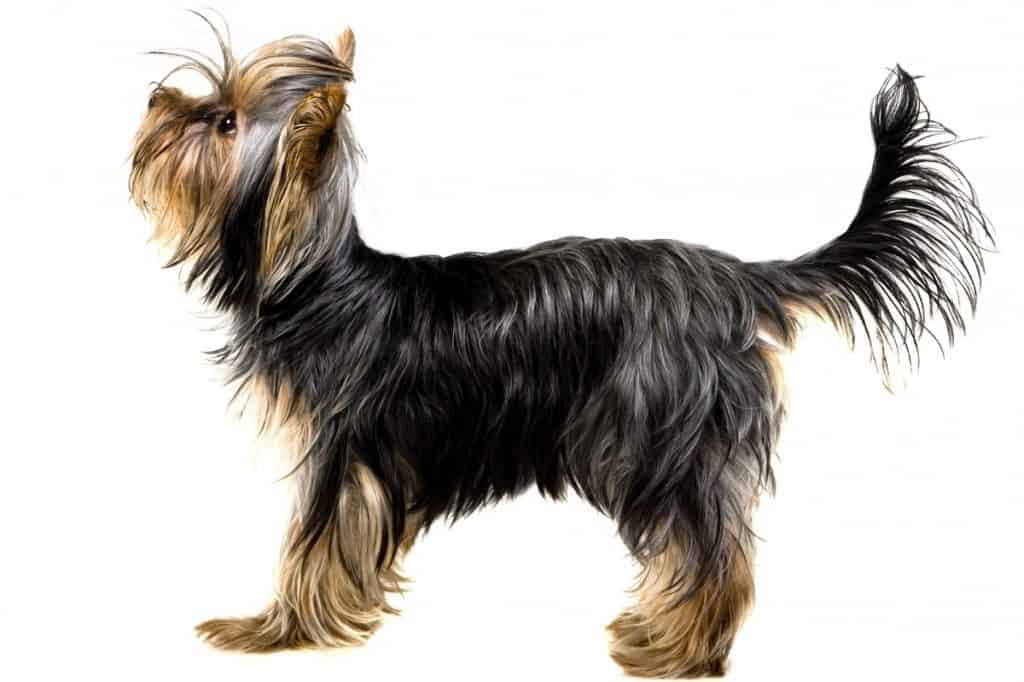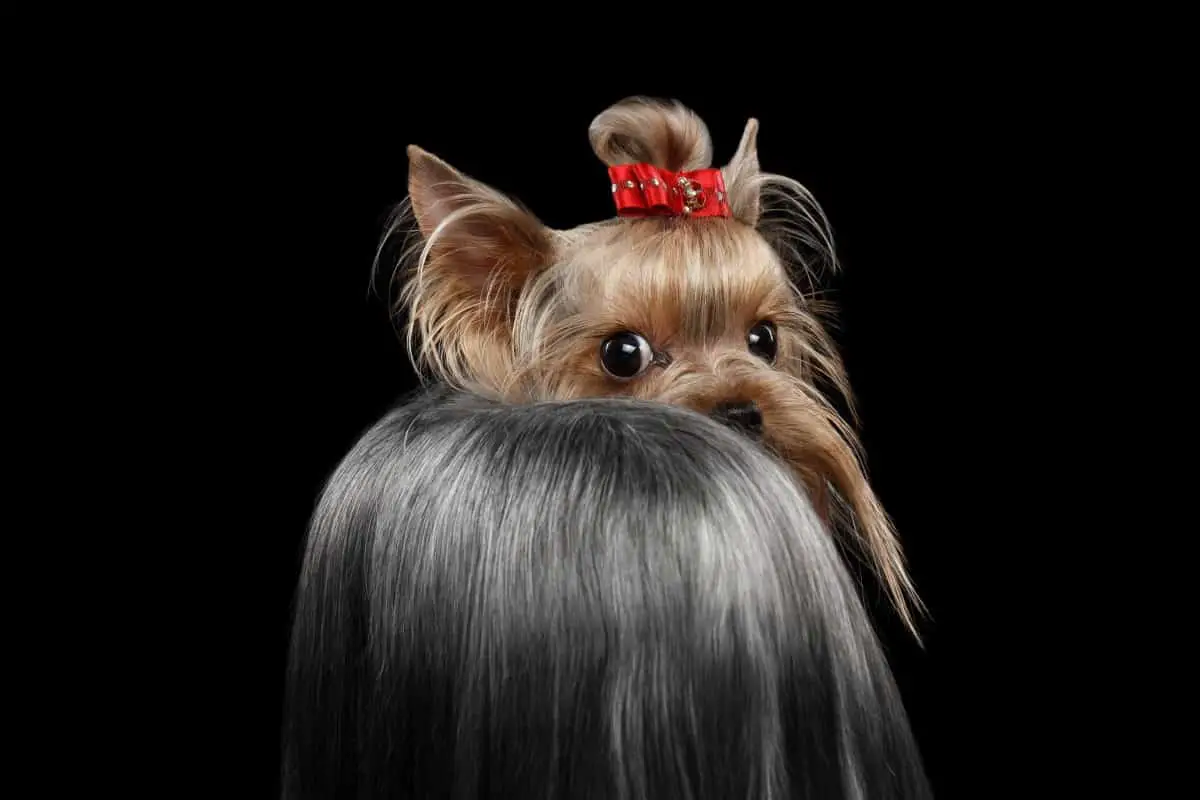Affiliate Disclosure: This post may contain affiliate links. If you make a purchase after clicking on these links I will be compensated at no extra cost to you. However, I never recommend anything I don’t love or wouldn’t use myself!
Yorkshire terriers are a small companion dog breed whose tails are traditionally docked when they are a few days old. There are many myths surrounding this controversial practice. Having researched the topic in detail, here is what I found.
Do Yorkies need their tails docked? Yorkies do not need to have their tails docked but it is still regularly practiced in the United States and is mandatory for Yorkies competing in American Kennel Club shows. However, tail docking has no medical benefits outside of a working environment and is illegal in many countries.
While Yorkies may not need their tail docked, if you’re entering them into a show, you should know how to go about it correctly and also whether it is even legal based on your location. Read on to find out more about the origins of this practice and how it is done today.
Do Yorkies Need Their Tail Docked?
In the past, tail docking served a purpose among working dogs, and on the whole, it was carried out with the Yorkies’ best interests at heart (more on this later).
These days, as far as standard household companion pets, it has no significant benefits and is usually only carried out for cosmetic purposes.
With this in mind, I can confidently say that companion Yorkies do not need to have their tails docked and I would strongly advise against it. However, this subject is still a controversial one.
The American Kennel Club, also known as the country’s leading authority on dogs since 1884, states the following within the Yorkshire Terrier breed standard:
Tail: Docked to a medium length and carried slightly higher than the level of the back.
www.akc.org
This means, in order to be entered into an AKC competition, show quality Yorkshire terriers need to have their tail docked to comply with AKC standards.
Tail docking can be safer for certain working breeds in particular scenarios even today, therefore it shouldn’t necessarily be ruled out entirely with blanket legislation.
However, the fact that dogs must have their appendages amputated (often unsafely and without anesthetic) purely for appearance in order to adhere to outdated, human-defined breed standards is not something that I agree with.
Fortunately, opinions are changing, and these days this train of thought is not commonly held throughout most of the developed world.
Where is it Illegal to Dock a Yorkie’s Tail?
In the United Kingdom and across most of Europe, show dogs are no longer docked for cosmetic purposes.
In England and Wales, this practice is illegal with the exception of a few exclusive working breeds. Nonetheless, Yorkshire terriers in England and Wales are not allowed to have their tails docked if they are to be entered in shows or purely kept as pets.
Since 2004, tail docking has been completely banned in Australia also and cannot be performed unless a veterinarian has a medical reason to amputate the tail.
Across most of the third world, animal welfare laws are almost nonexistent. The practice of tail docking (among other controversial animal practices) is largely unrestricted by legislation in these countries.
Companion Yorkies Do Not Need Their Tail Docked
Many people agree that if you have a Yorkie as a pet, you do not need to dock their tail.
There is no need if your Yorkie doesn’t partake in AKC dog shows or is not a working animal such as a rat catcher.
As I previously mentioned, there are no medical benefits for docking a Yorkie’s tail outside of a working environment. It’s purely aesthetic in these cases and done to emulate the traditional appearance of the breed.
In most modern countries, it is illegal to dock a dog’s tail because it’s considered painful and cruel, as well as an unnecessary medical risk to the health of the dog. In those countries, you can even be arrested or fined for animal abuse if you’re caught docking dog tails.
The United States is the exception to this rule, and in the United States, you can dock a dog’s tail legally as long as it’s done by a certain age and under specific conditions.
Show Yorkies Must Have Their Tails Docked in the US
Despite the controversial nature of tail docking, the American Kennel Club still requires Yorkshire terriers to have a docked tail in accordance with their AKC breed standard for dog shows.
Some pet owners who raise Yorkies as household companions also insist that their dogs have a docked tail in order to accurately represent the traditional look of the breed.
It has been suggested by some people (including the AKC) that, since the puppies are only a few days old, they don’t feel pain when the tail is docked. However, this theory is heavily disputed and does not have any basis in medical or scientific fact.
The truth is that almost all vertebrates are completely capable of feeling pain as very young infants, and this pain can even negatively affect their development.
However, since this pain is temporary, and humans regularly undergo painful rituals for cosmetic purposes themselves, many do not see this procedure as harmful or scarring in any way.

The Origins of Tail Docking
Tail docking is a practice that is undertaken across multiple breeds of dogs (mostly working breeds) and has a centuries-old history in human culture.
The ancient Romans were the first people recorded to dock tails, and the practice came about because the Romans mistakenly thought that cutting off part of a dog’s tail (and sometimes parts of its tongue) could help prevent it from contracting rabies.
Tail docking was also performed on dogs of poor or working-class, to signify that these dogs were not suitable for hunting game like a nobleman’s dogs (tails were considered vital for a dog’s hunting ability).
The tradition of tail docking was taken up again in modern Western civilization, although this time for different reasons. Oddly, this time around, tail docking was a practice carried out specifically on hunting dogs in order to prevent the dog’s tail from being injured during hunting or combat with another animal.
However, there are references of veterinary opposition to the practice particularly with regard to cosmetic purposes going back as far as 1857 in The Dog by Youatt and Lewis.
The History of Tail Docking in Yorkshire Terriers
While these days, Yorkies are classified as a companion breed, back during their heyday as a working breed in industrial England, Yorkshire terriers were tough little dock dogs whose main purpose was to catch and kill the many rats that plagued the many factories and shipyards.
These large rats were vicious fighters and were especially prone to biting a dog’s tail and clamping on for dear life, making it difficult for the terrier to get a killing blow in to finish them off.
Back then, there were no antibiotics or good healthcare treatments available for dogs, so a dog that was bitten by a rat could develop an infection and die. It was important that the rats be given as little opportunity as possible to bite the dog before the dog could bite (and kill) the rat.
Because of this working necessity (and in mimicry of European dogfighting and war dog breeds that also sported docked tails in order to avoid a disadvantage or injury during a fight), owners of working Yorkshire terriers began docking their tails so that the rats would not have an easy target to bite down on.
The AKC also notes that some dogs that were bred to hunt burrowing animals in the ground, such as the Airedale Terrier, have a strong base of the tail. Strong enough so that it can be used to pull the dog to safety if needed.
However the tip of their tail is much weaker and prone to splitting or breaking, therefore it is safer for it to be removed. They also note that breeds that have weak tails with wispy hair are more likely to be injured when running through brambles or thick brush.
Docked Tails: Myths vs Facts
Because tail docking has been around for such a long time in human history and has been done for so many reasons (and probably because it is a controversial and strongly-contested practice), there are many myths surrounding it. Here are some of the myths and corresponding facts about tail docking dogs:
Myth: Tail docking doesn’t hurt a puppy as long as it’s done when the puppy is young.
Fact: Tail docking on puppies even just a day old has been shown by veterinary studies to inflict intense amounts of pain, and it is theorized that it is even more painful for a day-old puppy to have their tail amputated than an older dog due to slower conduction of neurological impulses in the unmyelinated fibers of their still-developing nervous system.
Myth: Tail docking must be done to maintain the breed’s appearance standard.
Fact: Show dog appearance standards have changed throughout the years as dog-related cosmetic trends change, and new breeds are added all the time. The decision to not allow long-tailed dogs in any show dog standard is an arbitrary one purely related to human aesthetical preference.
Myth: Tail docking is a purely cosmetic practice.
Fact: Historically, tail docking actually came about as the result of working animal practices. Yorkshire terriers and other common companion dog breeds were not originally pets, and tail docking was seen as a way to protect them on the job.
Myth: Tail docking is done under anesthesia.
Fact: While some vets will administer a local numbing agent or put older animals under anesthesia to amputate a damaged tail, tail docking in newborn puppies is done while the puppy is completely conscious, as newborn puppies are too small and fragile to undergo anesthesia.
Myth: Tail docking poses no medical danger to the dog.
Fact: Tail docking can cause chronic nerve damage or give rise to the formation of a neuroma or pinched nerve at the amputation site, which is extremely painful to the dog.
What’s the Difference Between a Natural Tail and a Docked Tail on a Yorkie?
Docked tails are so commonplace on Yorkies that many people have never even seen a Yorkie without one. Let’s cover some details about the differences between the two standards.
Appearance Differences
The first thing you’ll notice if you encounter a Yorkshire terrier with an undocked tail is the tail’s appearance. A natural Yorkie tail is long and often curls up over the dog’s back, similarly to a Shih Tzu and some other small companion breeds.


It is cut short, usually to only a few inches long, if it is cut in accordance with the breed standard. People often describe this shortened tail as a “nub.”
Care Differences
If a Yorkie is allowed to have a natural tail, there is no real difference in care other than the fact that the long silky hair on the Yorkie’s tail will need to be regularly brushed. This is in order to avoid mats and tangles since Yorkshire terriers are a non-shedding breed.
A docked tail on a Yorkie requires special medical care. Right after a Yorkie’s tail is first docked, it’s important that it be carefully cared for in order to avoid infection in the open wound. Experts recommend keeping the tail wound clean using warm water and a clean rag.
Daily cleaning of the site and application of a non-toxic antibiotic ointment can help to promote quick healing.
Once the wound from a docked tail heals, the hair will grow over the spot where the amputation wound once was. Once the docked tail is completely healed, the only difference in care is that the docked tail fur is less difficult to groom than it would be on a longhaired Yorkie.
While Yorkies that undergo tail docking need initial care, afterward they are just like any other undocked Yorkie aside from differences in appearance.
Is Docking a Yorkie’s Tail Painful for the Dog?
This is by far the most controversial aspect of tail docking dog breeds. On their website, the American Kennel Club states that puppies endure little to no pain during tail docking, but this flies in the face of modern veterinary studies and anecdotal evidence.
The argument from those who believe that puppies don’t feel tail docking when they’re young is that their nervous system is not fully formed, so it’s not fully functional. However, if a Yorkshire terrier is born healthy enough for you to worry about docking its tail, its nervous system is, in fact, fully formed and functional.
Because of this, many people believe that dogs feel pain when their tail is docked regardless of the age at which the operation is performed.
Take this YouTube video of tail docking, for example. Be warned—this is quite graphic and hard to watch for many (myself included). The puppy cries out, which is a clear sign of pain in most young vertebrate animals.
This is why tail docking is illegal in most countries and is restricted even within many states in the United States as well.
What are the Risks of Docking a Yorkie’s Tail?
Besides the medical risks involved, docking a Yorkie’s tail leaves them at a massive disadvantage when it comes to communicating properly with other dogs. Dogs use their tails as one of their main modes of communication, both amongst themselves and with other animals such as humans.
By docking the tail, humans effectively cut the dog off from being able to express itself fully. In the case of meeting strange dogs, this can often lead to miscommunications and fights, especially since terriers have a tendency to be touchy around new dogs anyway.
This can lead to Yorkies with docked tails being involved in more small-scale dog fights and other problems related to their inability to express themselves to other dogs.
Dogs also use their tails to function as a rudder when they’re swimming, which means dogs with a docked tail are usually not as good at swimming as dogs who have a tail. While Yorkies can swim, most do not like to anyway.
It is also said that dogs also use their tails for balance, particularly when walking across narrow surfaces, which means a dog with a docked tail may be clumsier.
How Do You Dock a Yorkie’s Tail?
Those Yorkie owners who live in a country where they are legally allowed to dock their Yorkie’s tail can follow the procedures outlined below. Keep in mind that these common procedures are not against the law in the United States but may be restricted in some areas.
If you’re not sure whether or not you’re allowed to dock your Yorkie puppies’ tails, contact a veterinarian and check local legislation to make sure.
Puppies 2-5 Days Old
If a Yorkshire terrier puppy is two to five days old, their tails can be docked at home via one of the two methods mentioned below. Make sure to follow proper safety precautions before you begin or leave these procedures to a vet.
Note: It is illegal in certain states in America to do this operation unless you are a licensed veterinarian, including the state of Maryland. Again, check with a vet to make sure that what you’re doing is legal before you start docking puppy tails yourself.
The following precautions should be taken when docking dog tails at home:
- Keep a sterile environment: One of the largest dangers of performing any operation, no matter how minor, outside of a medical setting is the risk of infection. Because puppies are so young and fragile, even a minor infection may kill them if left unchecked. Be sure to keep both the operation area and the wound site disinfected.
- Have a vet on stand-by: Even if you follow procedures to the letter, things can still go wrong, which is why most people do not perform medical procedures on their own animals. If you have a puppy develop an infection or begin to act strangely following a tail docking, don’t wait–call a vet and get them looked at by a professional, pronto.
The following are two methods that people use to dock Yorkie puppy tails.
Method One: See A Vet and Have It Done
This first method is often seen as the more humane method of having tails docked, and this involves having a veterinarian do it. Vets dock tails with surgical scissors or a razor-sharp medical grade scalpel.
This minimizes potential pain, and performing the surgery in a sterile medical environment minimizes the risk of infection.
If a puppy’s tail docked by a veterinarian, this procedure should be performed when the puppies are only 2-5 days old. After that period, most states require a vet to use anesthesia. Not only is this more expensive for the pet owner, but it is also risky to put such young puppies under anesthesia because of the small dosages required, and some may not recover.
If a veterinarian docks a puppy’s tail, they will usually charge an up-front examination fee of “$45-$75,” according to this article about tail docking on howmuchisit.org. They will also charge per puppy—“anywhere from $15 to $35” each.
Method Two: Do It Yourself
The second method used to dock Yorkie tails involves cutting off circulation at the middle of the tail with a ligature band–essentially a really tight tourniquet. This band cuts off blood flow to the tail, and after a few days the dead part of the tail falls off.
Like surgical removal, this procedure should be performed on the puppy between the age of two and five days. Not only is it illegal to dock a puppy’s tail without anesthesia after that point, but the puppy is also more likely to feel greater amounts of pain as a result of the amputation the older they are. To minimize discomfort, this should be done as soon after birth as possible.
While this second method is obviously less expensive than having tail dockings performed at a vet’s office, it also comes with many more medical risks since it isn’t performed by a medical professional, and is also considered more painful in the long run.
It is legal to perform either of these methods in the United States on puppies younger than five days old and older than two days. If tail docking is undertaken at home, be sure to follow all precautions carefully. If you have any questions or concerns, be sure to reach out to your vet.
Tail Docking When a Yorkie Puppy is Older Than Five Days Old
If a puppy is five days or older, they will legally require anesthesia and a vet to dock the dog’s tail, at least in the United States. This is because the older the puppy is, the more likely they are to feel increasing amounts of pain, according to experts.
Also, the larger the puppy is, the larger the subsequent amputation site is, and that means it takes longer for the docked tail to heal and increases the risk of complications.
For tail docking a litter of puppies, a veterinarian will charge anywhere from $450 to $1,100 (according to the same aforementioned article on howmuchisit.org).
This makes it a costly procedure, and many vets might not even perform the procedure at all if the puppy is older than five days in age. With the case of cosmetic surgeries, most vets reserve the right to refuse service if they believe it is a cruel or unnecessary practice.
What if I Don’t Want My Yorkie’s Tail to Be Docked?
If you live in the United States and decide to buy a Yorkshire terrier puppy from a breeder at six weeks or older, it’s likely they already had the puppies’ tails docked at a young age. If you specifically want a Yorkshire terrier with an undocked tail, you’ll ideally need to let the breeder know not to dock the tail before the puppies are born.
Keep in mind that if you acquire a Yorkshire terrier puppy in this way, you’ll likely be required to pay a holding fee for your puppy, or even pay for the entire puppy up front before it’s even born.
Since an undocked tail renders a Yorkie ineligible for the show ring, you really have to commit to buying one from the breeder to avoid having it done, since the dog will be pet quality with a full tail and will not be worth as much as a Yorkie puppy with a docked tail.
Some breeders may charge an extra tail docking fee on top of the puppy’s regular price, depending on how they are selling the puppies. And there are some breeders of pet quality Yorkshire terriers who refuse to dock tails at all, citing cruelty.
Having a Yorkie’s Tail Docked is Ultimately Up to the Owner Where It’s Legal
More and more often, dog owners are choosing to refrain from docking the tails of their Yorkies. This is the result of changing show dog standards (especially in the United Kingdom and Europe) as well as modern scientific sensibilities.
The ancient Romans may have believed docking a dog’s tail, and tongue protected it from rabies, but luckily people in the twenty-first century have risen above those kinds of barbaric superstitions about dogs and legislation is changing to reflect the renewed interest in the welfare of the animals.
There are still many legitimate reasons why working dogs would have their tails docked in modern society, and for this reason, vets still continue to allow the practice in certain cases. There can be no doubt, however, that this controversial practice is falling out of cosmetic favor in show dogs and companion animals.
While this practice remains legal in many parts of the world, it would not be surprising in a few decades if it has been eliminated from show dog standards entirely. New scientific studies show that this historical practice is not practical enough to justify causing unnecessary pain to man’s best friend.
For Pet Yorkies, Leaving the Tail Improves Their Lives
Due to the many functional uses that dogs have for their tails with regards to both coordination and communication with other dogs, it is beneficial to a Yorkie to have its tail left intact.
Besides these practical reasons for wanting to let a Yorkie keep its long sweeping tail intact, who doesn’t want to come home from work to a wagging tail?

